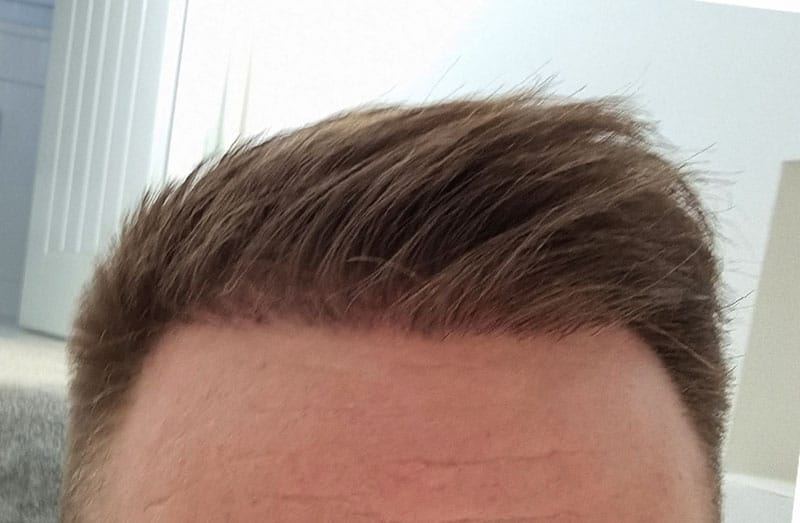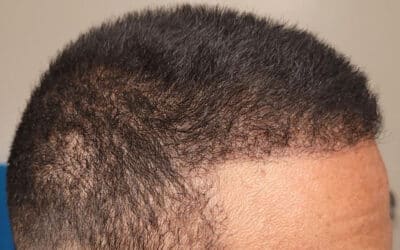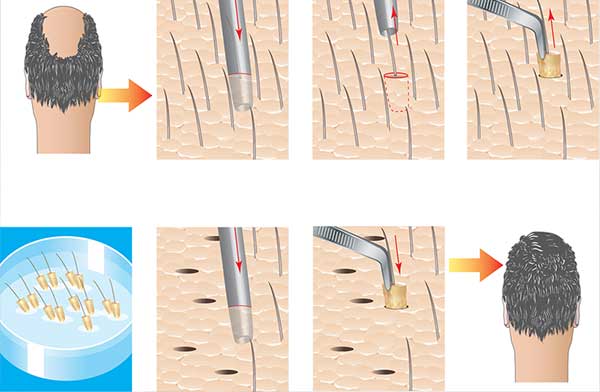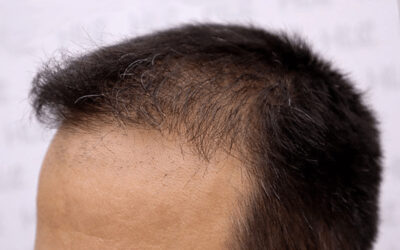Follicular Unit Extraction (FUE) is a widely-used hair transplant technique. Many are concerned about its risks if it can harm existing hair. Read this guide to learn the truth and decide confidently on your hair restoration.
Understanding FUE: What’s the Process?
Follicular Unit Extraction (FUE) is a method for hair transplantation. It involves removing and transplanting individual hair follicles. The process includes consultation, preparation, extraction, transplantation, recovery, and long-term care.
- Consultation: Meeting with a specialist to assess suitability and discuss expectations.
- Preparation: Shaving and cleaning the donor area to prepare for extraction.
- Extraction: Removing individual hair follicles from the donor area using specialized tools.
- Transplantation: Placing the extracted follicles into tiny incisions in the thinning areas.
- Recovery: Following aftercare instructions to ensure proper healing and optimal results.
Long-term Care: Ongoing maintenance to keep the transplanted hair healthy and natural-looking.
Table of Contents:
- What is FUE Hair Restoration?
- Can FUE Damage Existing Hair?
- How We Minimize Hair Loss and Damage During an FUE Procedure
- About Recovery After an FUE Procedure
- Understanding the Results of an FUE Procedure
- FAQs in Relation to Can Fue Damage Existing Hair?
- Conclusion:
The Impact of FUE on Existing Hair: Is There a Risk?

The impact of FUE on existing hair depends on several factors. These include the skill of the surgeon, the techniques and tools utilized during the procedure, as well as proper aftercare. It is important to note that while risks are present, potential damage can be minimized through professional expertise and adherence to instructions.
- Potential Damage: Incorrect extraction or placement can damage existing hair follicles.
- Skill Level: The experience and skill of the surgeon can significantly affect the outcome.
- Technique and Tools: Using up-to-date methods and tools minimizes the risk of damage.
- Pre-existing Conditions: An underlying scalp condition might increase the risk of complications.
- Aftercare Compliance: Following aftercare instructions is crucial to avoid unnecessary stress on existing hair.
- Professional Insight: Regular follow-ups with the surgeon or specialist ensure that the process is on track and any concerns are addressed promptly.
Expert Opinions on FUE and Its Safety
Hair transplantation experts generally consider FUE as a safe and effective method when performed by a skilled surgeon. However, opinions may vary regarding specific cases and individual suitability.
- Professional Endorsement: Many leading surgeons recommend FUE for its minimally invasive nature.
- Safety Concerns: Experts note that patient selection, surgeon experience, and proper aftercare are crucial to safety.
- Latest Research: Ongoing studies provide insights into FUE technology’s long-term effects and improvements.
- Patient Satisfaction: High patient satisfaction rates reflect the consensus on FUE’s efficacy and safety.
Comparing FUE with Other Hair Transplant Techniques

Follicular Unit Extraction (FUE) is a hair transplant technique that offers unique features, benefits, and drawbacks. By comparing FUE with other methods such as Follicular Unit Transplantation (FUT), individuals can determine the procedure that best suits their specific needs.
- Invasiveness: FUE is less invasive compared to some other techniques.
- Scarring: Different methods leave varying degrees of scarring.
- Recovery Time: Recovery duration may differ between techniques.
- Cost: Cost considerations may vary based on the method chosen.
The table below illustrates the differences between FUE and other standard hair transplant techniques, helping patients and professionals make informed decisions.
| Aspect | FUE | FUT (Strip Surgery) | Other Techniques (e.g., Scalp Flaps, Punch Grafts) |
| Procedure | Individual follicular units are extracted directly from the donor area. | A strip of skin with hair is removed from the back of the scalp and then dissected into individual grafts. | Larger sections of the scalp or hair are transplanted. |
| Scarring | Tiny dot scars that are often hard to detect, even with short hair. | Linear scars at the donor sith can be visible with short hair. | Larger, more visible scars due to the size of the graft/flap. |
| Recovery Time | Generally quicker with less discomfort. | Slightly longer due to suturing/stapling of the strip site. | Varies, but often longer due to more extensive procedures. |
| Number of Grafts | Suitable for smaller sessions. | Can harvest a large number of grafts in a single session. | Varies depending on the technique. |
| Invasiveness | Minimally invasive. | More invasive due to strip removal. | More invasive, given the size of the sections being moved. |
| Technique Evolution | Newer technique, constant refinements. | Established method, but less popular in recent times. | Older techniques are less commonly used today. |
| Pain/Discomfort | Usually less post-operative pain. | Some discomfort at the strip site. | Varies, but often more discomfort due to the nature of the procedure. |
| Cost | Typically more expensive due to the time and precision involved. | Generally less expensive. | Cost varies widely based on the procedure and location. |
| Hair Density Outcome | Can achieve high densities if donor supply is good. | High densities are achievable. | Varies, but often less natural-looking results. |
| Best For | Patients who want to wear hair very short and are concerned about visible scars. | Patients needing many grafts or those less concerned about a linear scar. | Those who may not be candidates for FUE or FUT. |
Protecting Your Existing Hair during FUE: Tips and Precautions

Protecting existing hair during an FUE procedure is essential to achieving successful results. Adhering to specific tips and precautions ensures the safety of the hair and promotes optimal healing.
- Choose a Skilled Surgeon: Finding an experienced professional ensures the procedure is done correctly.
- Follow Preoperative Instructions: Adhering to the guidelines before surgery minimizes risks.
- Gentle Postoperative Care: Following aftercare instructions supports healing and protects existing hair.
- Avoid Unnecessary Stress on Hair: Refraining from pulling or tugging on hair aids in recovery.
- Monitor the Healing Process: Regular follow-ups with the surgeon help identify potential issues early.
- Avoid Heat and Chemical Treatments: Keeping away from such treatments initially helps protect hair.
Long-term Effects of FUE: What Research Tells Us

The long-term effects of FUE are an essential consideration for anyone contemplating this procedure. Scientific research provides insights into the lasting impacts, success rates, and potential challenges.
- Lasting Results: Research shows that FUE can provide permanent hair restoration in most cases.
- Potential Complications: Studies identify risks such as scarring or infection, which can usually be managed with proper care.
- Patient Satisfaction: Most patients report high satisfaction with the appearance and feel of transplanted hair over time.
- Ongoing Maintenance: Long-term care and potential follow-up procedures may be needed for best results.
- Advancements in Technology: Continuous research and technological innovations improve the procedure’s effectiveness and safety.
FUE is a popular hair transplant technique that many find appealing for its minimal scarring and natural-looking results. While concerns about its impact on existing hair are expected, following the right precautions and consulting with experienced professionals can mitigate these risks. Like any medical procedure, it’s vital to be well-informed and to seek out the guidance of experts in the field.
Ready to take the next step in your hair restoration journey? Don’t let concerns hold you back. Book a consultation with our expert team at Hair Transplants Los Angeles. Our skilled professionals will provide personalized consultation, answer all your questions, and guide you through the options best suited to your needs. Experience the confidence and transformation that comes with a fuller head of hair.
FAQs in Relation to Can Fue Damage Existing Hair?
FUE, or Follicular Unit Extraction, is a hair transplant method that involves removing individual hair follicles and transplanting them to thinning areas.
While risks exist, proper care, technique, and an experienced surgeon can minimize potential damage to existing hair.
FUE might not be suitable for everyone. A consultation with a specialist can determine if it’s the correct procedure for your situation.
Recovery can vary, but most patients can return to normal activities within a week. Some might experience slight discomfort or swelling.
There are other hair transplant techniques, such as Follicular Unit Transplantation (FUT). A consultation with a professional will help identify the best method for you.
Now You Know Can FUE Damage Existing Hair
At this point, you should understand can FUE damage existing hair and make an educated decision if the procedure is right for you.
The FUE hair restoration procedure is a great option for those looking to restore their hair permanently. It can be done with minimal damage to existing hair. Just so long as the patient and doctor take all necessary precautions. By taking the right steps during and after your FUE treatment, you’ll achieve a natural-looking outcome. One you’ll love and be happy with for many years to come.
So if you’re considering an FUE procedure and you’re worried about FUE damaging your existing hair, don’t let worries about potential damage stop you from getting the look you want. Just make sure to ask your doctor any questions about the risk of damage when performing the procedure. Got further questions? Contact us for more details.
Best Hair Transplant
1970 S. Prospect Ave., Suite 2
Redondo Beach, CA 90277
(213) 403-0455
https://www.google.com/maps?cid=9280610872186794918
To ensure your ease of mind, you can view our customer recommendations HERE. Furthermore, you can also see our Google reviews and Yelp reviews. We can’t wait to help you start restoring your lost hair.












